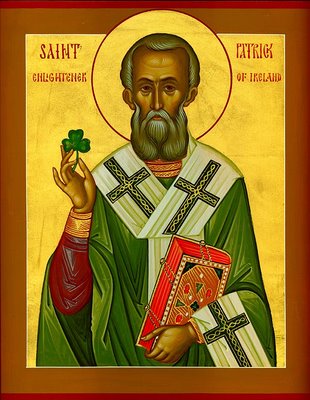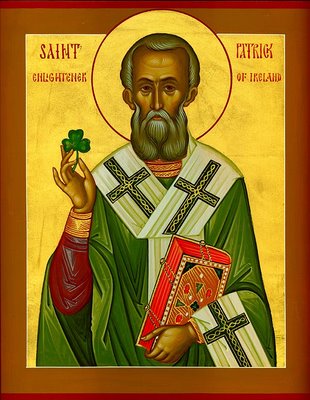St. Patrick’s Day – In March we celebrate a day called St. Patrick’s Day. So what exactly is St. Patrick’s Day and who is Saint Patrick?
St. Patrick’s Day

March 17 (76th day of the year, unless it’s a leap year – 77th) is when we celebrate Saint Patrick’s Day. It is a day of green. Remember as a kid if you didn’t wear green you could get pinched. You also hear about Three and even Four Leaf Clovers (known as Shamrocks), methodological creatures called leprechaun’s & even rainbows with a pot of gold at the end of it.
Mostly Celebrated in Ireland
Did you know that this day was mostly celebrated in Ireland, originally and then went outside of Ireland. This day was to celebrate the death of Saint Patrick. The Dioceses of Ireland says it is a solemnity and a holy day of obligation.
Brief about Saint Patrick
Saint Patrick was a 5th-century Romano-British Christian missionary (he went out and evangelized). He was also a bishop in Ireland. Some people know him as “Apostle of Ireland”. He was also the primary patron saint of the island. Saint Patrick lived during the second half of the 5th century.
The Holiday!
St. Patrick’s Day became an official Christian feast day in the 17th Century. Note: “Christian” despite the world tries to make it secular. It is most commonly celebrated by the Catholic Church, Anglican Communion and Church of Ireland. It is also to celebrates the culture and heritage of the Irish.
Reason why you hear a lot about drinking on this day is due the fact that Lenten restrictions were lifted for this day. I personally believe as Christian you will want to abstain from things that impair you. Check out 10 Reasons Christians Shouldn’t Drink.
It is a public holiday in Republic of Ireland, Northern Ireland, Newfoundland, Labrador and Montserrat. It is usually celebrated also in Britain, Canada, the United States, Argentina and New Zealand to name a few countries, but isn’t considered a Federal Holiday.
Shamrock symbolized rebirth
In ancient Ireland, the shamrock symbolized rebirth, particularly the rebirth of warmer weather. But the shamrock also has more specific ties to St. Patrick, and remains one of the most recognizable symbols associated with his feast day. Historians believe that, on his return to Ireland (a native of Great Britain, St. Patrick was first taken to Ireland after being kidnapped by pirates, later returning as a Christian missionary after his release).
St. Patrick used the shamrock to teach the natives about the Holy Trinity. In fact, an image of St. Patrick holding a shamrock first appeared on coins in 1675. The shamrock’s status as a symbol would continue to evolve when it became a figure of Irish patriotism during the Irish Rebellion of 1798. In 2003, the shamrock, registered as an international trademark by the Irish government.
3 Leafed Clover
A 3 Leafed Clover represents the Trinity (Father, Son and the Holy Spirit); according to the pagan Irish. Seamróg is the Irish word where Shamrock comes from meaning, “little clover.” Saint Patrick firmly believed in the trinity. This is one reason he kept referring to the trinity and using the shamrock or the 3 leafed clover to demonstrate the trinity.
4 Leaf Clover
The 4 leaf clover is rare to find. That is why many believe it brings luck when you find one. However, some people believe the four leaf clover repents: Faith, Hope, Love and Luck. But, we know that believing in Christ, there is no such thing as luck. Everything that happens is appointed by God.
Check out the confession of Saint Patrick
This is from the Confession of St. Patrick 4 A.D. 452.
“[T]here is no other God, nor ever was, nor will be, than God the Father unbegotten, without beginning, from whom is all beginning, the Lord of the universe, as we have been taught; and His son Jesus Christ, whom we declare to have always been with the Father, spiritually and ineffably begotten by the Father before the beginning of the world, before all beginning; and by Him are made all things visible and invisible. He was made man, and, having defeated death, was received into heaven by the Father; and He has given Him all power over all names in heaven, on earth, and under the earth, and every tongue shall confess to Him that Jesus Christ is Lord and God, in whom we believe, an whose advent we expect soon to be, judge of the living and of the dead, who will render to every man according to his deeds; and He has poured forth upon us abundantly the Holy Spirit, the gift and pledge of immortality, who makes those who believe and obey sons of God and joint heirs with Christ; and Him do we confess and adore, one God in the Trinity of the Holy Name” (Confession of St. Patrick 4 [A.D. 452]).
The Color Green
Green used with holiday because it has long since been used for Ireland, dates around 1640s. Even the Chicago River, dyed Green for St. Patrick’s Day. Imagine if they painted it red for Valentine’s Day. I bet that would remind of the Nile River when God had it turned into blood.
Celebrants may be surprised to learn that blue is the color that was once most affiliated with St. Patrick himself. Numerous paintings depict St. Patrick wearing blue vestments. But green is the color now most instantly associated with Ireland, which is widely referred to as the “Emerald Isle.” Ireland’s lush countryside and rolling green hills attract millions of visitors each year. The color green is found just about everywhere on St. Patrick’s Day, even if Patrick himself was partial to blue.
While you are at it, check out all things green!
Don’t call it “Patty’s” Day!
According to experts on Irish culture, the shortened “Paddy,” and not “Patty,” should be used when referring to St. Patrick’s Day. Paddy, derived from the Irish name “Pádraig,” which is the equivalent of the English “Patrick.” Not to mention, “Patty” is actually a shortened form of Patricia, which happens to be a woman’s name.
Plus, one individual has gone on his own personal crusade to correct people around the world as to the correct way to refer to St. Patrick’s Day, should the name need to be shortened. Marcus Campbell has copyrighted the website PaddynotPatty.com to inform people why “Paddy” is the correct way to shorten the name. Not to mention, Campbell goes on to state that Paddy, Pat, Packie, Podge, Pád, and Pod are all perfectly acceptable substitutions for Patrick. Just steer clear of Patty.
No Matter How Much!
No matter how much the world tries to take out God, if you really look deep enough most of all things you will see that God had a start in it or a bases in it. Just like the start of our nation, United States of America. Just the devil wants to try to take credit and make it more secular.
Do you celebrate St. Patrick’s Day?
Feel free to share in the comments below about why or why you don’t celebrate.
Do you wear Green?
Tell me why or why you don’t wear green on this day?
What do you know about St. Patrick or even St. Patrick’s Day?
Feel free to share in the comments below!
First published March 16, 2021. Last updated or republished March 17, 2024.
St. Patrick’s Day Blog Posts

- All Things Green
- All Things Orange
- A-Z of St. Patrick’s Day
- Celtic Cross
- Colors of St. Patrick’s Day
- Don’t mistake a shamrock for any old clover
- Harp
- Irish Flag
- Meaning behind popular St. Patrick’s Day symbols
- Meaning behind the shamrock
- Millions of People Claim Irish ancestry
- Origins of the leprechaun myth
- Prayer of St. Patrick
- Rainbows
- St. Patrick’s Day
- Top 5 Countries with Irish populations
- Unique, mysterious and lesser-known facts about Ireland
- Wearing orange instead of Green on St. Patrick’s Day
- Who was St. Patrick
- Why does the world celebrate St. Patrick’s Day?
Check out Courageous Christian Father’s Wish list on Amazon where you can purchase and this items sent directly to him and they will be used for the ministry.
Subscribe To Courageous Christian Father!
Don’t miss any blog posts! Subscribe today! You can subscribe via WordPress or by entering your email! Thank you!
Follow Courageous Christian Father on WordPress.comFollow Courageous Christian Father on Social Media
Recent Posts:
Below are some examples of blog entries from all the blogs that I do. (Courageous Christian Father, Steve Sews Stuff, SteveZ DuckZ, and SteveZ DesignZ).
Thank You For Reading Courageous Christian Father!
Thank you for reading. Please feel free to share and like this blog post.
Clipart: Unsplash, Pixabay, Pexels, Openverse, Adobe Express, Adobe Stock, FreePik, MetroCreative, and more. This site uses Amazon Affiliate Ads & Google Ads.
Sources:
- WikiPedia Source 1
- WikiPedia Source 2
- Metro Creative TF173844 & TF173846
- Jimmy Akin
First published this article March 17, 2014. Last republished March 17, 2021.
About the Author
Discover more from Courageous Christian Father
Subscribe to get the latest posts sent to your email.



